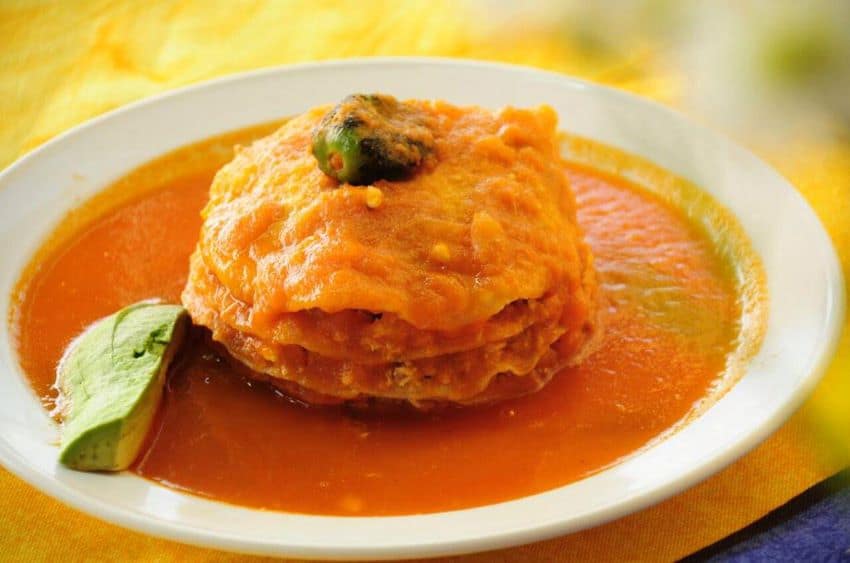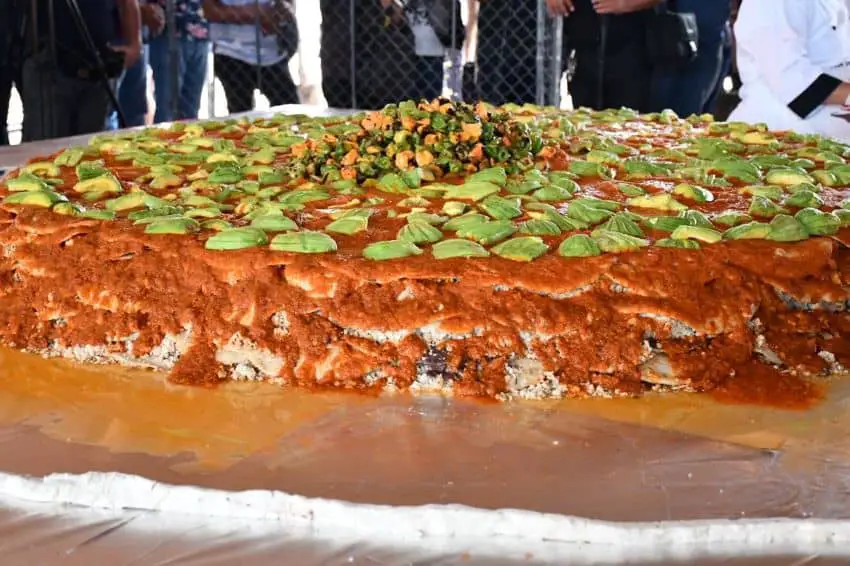If you’ve never had dogfish — called cazón in Spanish and referring specifically to a small species of shark in Mexico — then you’ve probably never been to Campeche. That’s because many of the best dishes from this state rely on dogfish for flavor, from dogfish empanadas, panuchos and salbutes, to dogfish-stuffed xkatik chilis, the shredded dogfish in a corn tortilla with pumpkin sauce known as papadzules and the state’s signature dish: pan de cazón, or dogfish bread.
Dogfish may not sound particularly appetizing, and there are certainly those who have proven immune to its culinary charms, including two notable French visitors to Campeche during the 19th century, Ludovic Chambon and Désiré Charnay. The former described it as flavorless and “so stringy that one imagines having a bundle of thread in one’s mouth.” The latter was repulsed by the way the sharks were publicly gutted, noting the “piles of entrails that spread a pungent smell that anxiously await a flock of small and hungry vultures.”

However, that’s not the reaction of most visitors and certainly doesn’t represent the feelings of locals, many of whom talk about pan de cazón and its delicate flavors with the same breathless passion as a poet swooning over a returning lover. A local magazine aimed at tourists, for example, once described it as “a delicacy worthy of the gods.”
The seafood bounty of Campeche
There’s good reason for Campeche’s love affair with the dogfish. In addition to their Maya heritage, evident in beloved local dishes like cochinita pibil and pibipollos, Campechanos have always enjoyed access to a bounty of fresh seafood, thanks to their state’s location on the Yucatán Peninsula.
This includes the best shrimp in Mexico, often prepared deliciously with coconut, plus amberjack, corvina, grouper, octopus, pompano, red snapper, sea bass, squid and yes, dogfish, whose abundance led to its adoption as a culinary staple by the poor by the 19th century.
The preparations for Campeche’s seafood and wild game specialties showcasing turkey, wild boar and venison reflect not just the legacy of Maya civilization, but also Spanish influence and centuries of coastal incursions by Caribbean pirates. The result is a fascinating and versatile cuisine.

However, like the one in neighboring Yucatán state, Campeche dishes are similar in that they often showcase one or more of a trinity of essential regional ingredients. Sour orange and achiote, for example, are indispensable to cochinita pibil yet also contribute distinctive flavor and an unmistakable orange color to a myriad of local favorites. Habanero chili is the third vital ingredient in Campeche cuisine. Prized for its spiciness, habanero is an absolute necessity for many regional dishes, not the least of which is pan de cazón.
What’s so special about pan de cazón?
Five primary ingredients are needed for pan de cazón in total: shredded dogfish, refried black beans, corn tortillas, tomato and habanero chili. The last two are the backbone of the dish’s amazing sauce, as richly colored and creamy as a fine Italian marinara. This comparison is not made lightly, it must be noted. Because its ingredients are layered between tortillas, pan de cazón looks like some strange cousin of lasagna.
Typically, there are not one, not two, but three tortillas used to frame the arrangement, with the dogfish and beans packed in between them. The dish is then covered in sauce, often with a topping of avocado. It makes a good starter or main course, with additional ingredients like onion or epazote sometimes included to provide more intense flavors. The dogfish — hundreds of thousand pounds of which are caught annually in Campeche — is mild yet tasty, with a hint of sweetness. It’s also quite nutritious, providing ample protein with very little fat.
Want to know what to eat in Campeche? Check your calendar
Is there a bad time to eat pan de cazón in Campeche? No, but there is an established culinary calendar, just as in many other parts of Mexico. If you’re in Guerrero, pozole will be served on Thursday. That’s where the phrase “jueves pozolero” originated, after all.
In Campeche, historically, there are foods associated with almost every day. On Monday, locals eat puchero, a stew of Spanish origin featuring beef broth and vegetables. Stews and casseroles are an integral part of the local cuisine. Seafood dishes like pan de cazón are typically consumed on Friday. Yes, this is because of the Catholic custom of abstaining from meat on Fridays and eating seafood instead. On Saturday, the day men traditionally go to market — a legacy of Campeche’s piratical past — a beef and organ meat stew called chocolomo is served for dinner. Sunday specialties include lechón (suckling pig) and a three-meat stew.
The spirit of the Campechano
Several traditional drinks are served in Campeche. Tanchucuá is the most famous of these, if only for its antiquity. It’s made from corn and chocolate, two time-honored Maya ingredients. However, as a pairing option, it more commonly accompanies pibipollos, a large tamal served on Día de Muertos. To go with pan de cazón, you could try aguas frescas like horchata, popular locally, or the Campechano version of the Cuba Libre made with rum and equal parts Coca-Cola and soda water.
The word “campechano” deserves special mention for its versatility. Campechano originally referred solely to the people who live in Campeche. But due to their famously relaxed and open attitude, the term has since become a Mexican synonym for laid-back. Since the 19th century, it has also entered the language in verb form as campechanear, which denotes something mixed.
Tacos campechanos are the obvious example. This taco style requires two or more meats. However, like the Cuba Campechana, as the Cuba Libre with soda water is known, it’s named for being a mix, not necessarily for any regional affiliation with Campeche. You’re more likely to find both of these items in Mexico City — for the tacos campechanos, try the amazing El Villamelón.
Chris Sands is the Cabo San Lucas local expert for the USA Today travel website 10 Best, writer of Fodor’s Los Cabos travel guidebook, and a contributor to numerous websites and publications, including Tasting Table, Marriott Bonvoy Traveler, Forbes Travel Guide, Porthole Cruise, Cabo Living and Mexico News Daily. His specialty is travel-related content and lifestyle features focused on food, wine and golf.
